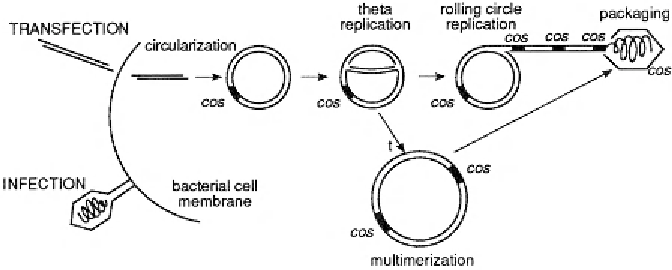Biology Reference
In-Depth Information
Figure 6.2
The typical lytic cycle of bacteriophage
λ
begins when the phage adsorbs to an
E. coli
cell
by the tail fiber. The linear DNA molecule is injected into the host cell where it circularizes by anneal-
ing at the
cos
sites. The
λ
DNA replicates by a “rolling circle” mechanism, producing long concat-
enated molecules with the individual chromosomes annealed at the
cos
sites. Later in the infection
cycle, phage genes for the protein head and tail are turned on. When these components are produced,
the replicated DNA is packaged into the icosahedral head after the concatenated DNA is cut at the
cos
sites. If the DNA is too long or too short, it will not be packaged in the head, but will be lost. Lysis of
the host cell then occurs, typically releasing
≈
100 progeny phage that enter new cells to replicate.
In the
lytic
phase, early DNA transcription establishes the lytic process, mid-
dle genes replicate and recombine the DNA, and late genes produce protein for
packaging the DNA into mature phage particles. Phage DNA is replicated in a
“rolling circle” mode (
Figure 6.2
). Multiple copies of the replicated DNA mol-
ecules are assembled in a linear tandem array, with the termini of each mole-
cule joined at the
cos
sites. The
cos
sites form the recognition site of a specific
endonuclease that cuts the DNA during the packaging process so that a single
DNA molecule is inserted into the head of the protein coat. In summary, in a
lytic infection, the phage takes over the host cell machinery: phage DNA is repli-
cated, head and tail proteins are made, the replicated DNA is packaged, and the
host cell is lysed to release
≈
100 infective particles.
In the temperate or lysogenic phase, most phage functions are repressed and
lysis is avoided. In lysogeny, the
λ
DNA is inserted into the host chromosome by
site-specific recombination and the phage genome (called a prophage) is rep-
licated as part of the
E. coli
chromosome. Nearly all
λ
vectors used in genetic
engineering lack the ability to enter the lysogenic phase.
λ
has been genetically improved as a vector: 1) Genes in the central region of
the chromosome that code for events associated with recombination and lysog-
eny have been deleted and can be replaced with exogenous DNA (
Figure 6.3
).
2)
λ
vectors have been engineered to contain cloning sites to facilitate the inser-
tion of exogenous DNA. Engineered versions are of two major types: insertion

